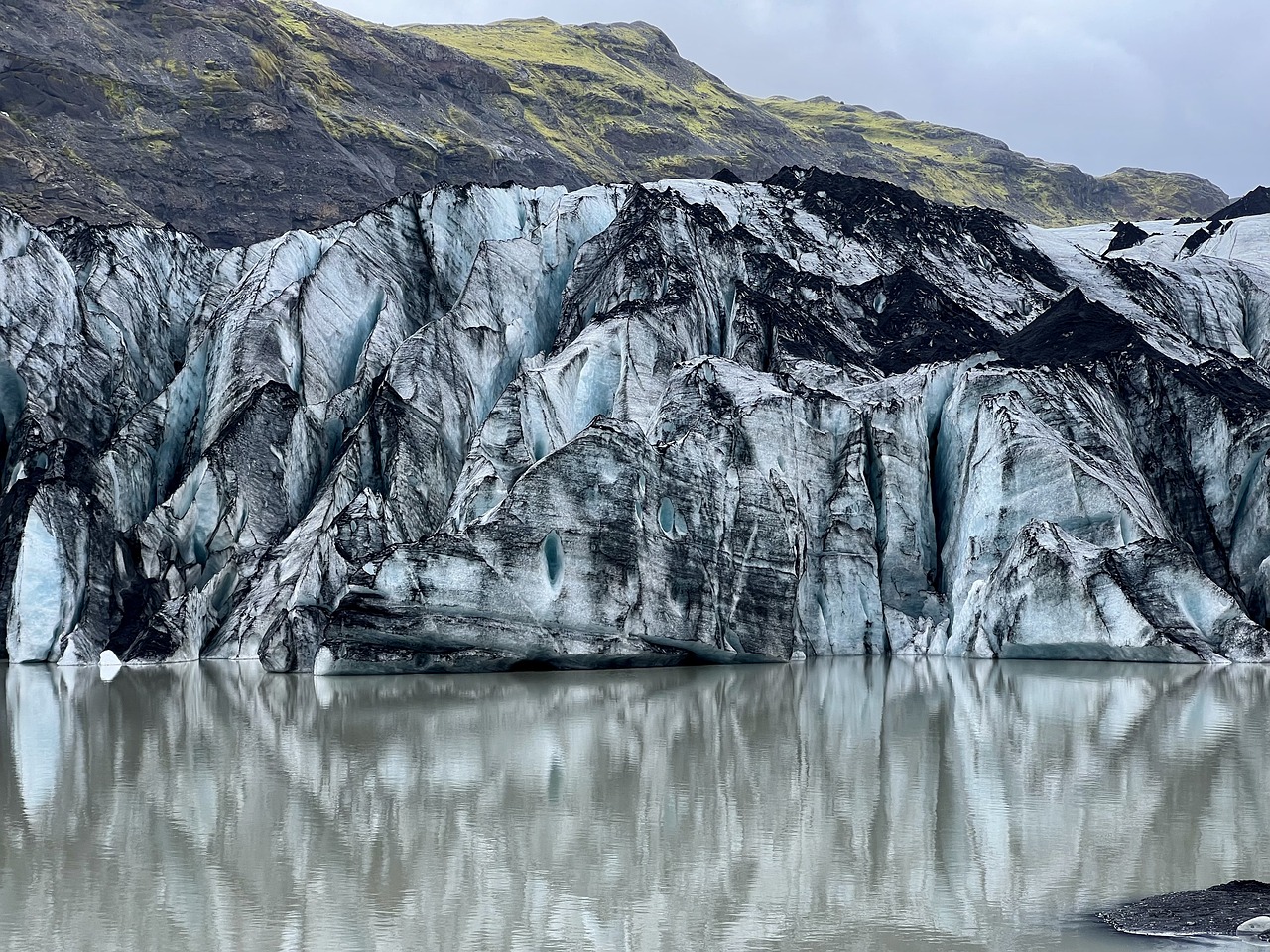Climate Change and Desertification: The Vicious Circle
In today's world, the terms climate change and desertification are often thrown around in discussions about environmental issues. But what do they really mean, and how are they connected? Imagine a vicious circle where one problem feeds into another, creating a cycle that is hard to break. This is the reality we face as climate change exacerbates desertification, leading to dire consequences for ecosystems, human health, and global economies.
Climate change refers to long-term shifts in temperatures and weather patterns, primarily driven by human activities such as burning fossil fuels, deforestation, and industrial processes. These actions release greenhouse gases into the atmosphere, trapping heat and causing the planet to warm. This warming is not just about hotter summers; it leads to extreme weather events, altered precipitation patterns, and shifts in ecosystems. On the other hand, desertification is the degradation of land in arid, semi-arid, and dry sub-humid areas, resulting from various factors, including climatic variations and human activities. The irony is that as the climate changes, regions that are already vulnerable to desertification become even more susceptible to its effects.
This interconnectedness creates a domino effect. For instance, as temperatures rise, we see increased evaporation rates and reduced soil moisture, which can lead to crop failures and food scarcity. In turn, this drives communities to overexploit their land in search of resources, further accelerating desertification. It's a cycle that can seem overwhelming, but understanding it is the first step toward finding solutions.
One of the most alarming aspects of this vicious circle is its impact on biodiversity. As desertification progresses, habitats are lost, and species that depend on those ecosystems face extinction. This loss of biodiversity not only affects the environment but also disrupts human livelihoods, particularly in rural areas where communities rely on the land for their survival. The challenge is not just to combat these issues individually but to recognize their interdependence and address them holistically.
As we delve deeper into the science of climate change and the causes and effects of desertification, it becomes clear that we must act decisively. The solutions are not just about mitigating the impacts but also about adapting our practices to ensure a sustainable future. This article will explore innovative agricultural practices, technological advancements, and the importance of community engagement in tackling these pressing challenges. Together, we can break the cycle and pave the way for a healthier planet.
- What is the primary cause of climate change? Climate change is primarily caused by the increase of greenhouse gases in the atmosphere due to human activities such as burning fossil fuels and deforestation.
- How does desertification affect food security? Desertification reduces the land's ability to produce food, leading to lower crop yields and threatening the livelihoods of farmers.
- What can be done to combat desertification? Sustainable agricultural practices, reforestation, and community engagement are essential strategies to combat desertification.
- Why is biodiversity important in the context of climate change? Biodiversity helps ecosystems remain resilient and adapt to changes, which is crucial for maintaining food security and human health.

The Science of Climate Change
Understanding the scientific principles behind climate change is essential for grasping its profound effects on our planet. At the core of this phenomenon are greenhouse gases (GHGs) such as carbon dioxide (CO2), methane (CH4), and nitrous oxide (N2O). These gases trap heat in the atmosphere, creating a greenhouse effect that leads to global warming. Picture the Earth as a giant greenhouse, where sunlight enters but struggles to escape, causing the temperature to rise. This increase in temperature not only affects weather patterns but also accelerates processes like desertification.
One of the most alarming aspects of climate change is its ability to create a vicious cycle. As temperatures rise, areas that are already arid become even drier, exacerbating desertification. This, in turn, releases more GHGs into the atmosphere as vegetation dies and soil degrades. For instance, deforestation—often driven by agricultural expansion and urban development—removes trees that would otherwise absorb CO2. According to the Intergovernmental Panel on Climate Change (IPCC), land-use changes contribute significantly to global emissions.
To illustrate the impact of greenhouse gases, consider the following table that outlines their sources and effects:
| Greenhouse Gas | Primary Sources | Effect on Climate |
|---|---|---|
| Carbon Dioxide (CO2) | Burning fossil fuels, deforestation | Global warming, ocean acidification |
| Methane (CH4) | Livestock, landfills, rice paddies | Stronger greenhouse effect than CO2 |
| Nitrous Oxide (N2O) | Agricultural practices, fossil fuel combustion | Contributes to ozone depletion |
As we delve deeper into the science of climate change, it's crucial to recognize the role of human activity. The Industrial Revolution marked a significant turning point, where reliance on fossil fuels skyrocketed, leading to an unprecedented increase in greenhouse gas emissions. This surge has not only altered our climate but has also disrupted ecosystems, pushing many species to the brink of extinction.
Furthermore, climate change is not just an environmental issue; it is a social and economic challenge as well. Vulnerable populations, particularly in developing countries, face the brunt of its impacts. As weather patterns become less predictable, agricultural yields decline, leading to food insecurity and increased poverty. It's almost as if we're playing a game of dominoes, where one issue triggers another, creating a cascade of challenges that are increasingly difficult to manage.
In summary, the science of climate change reveals a complex interplay of natural and human-induced factors that contribute to global warming and desertification. Understanding these dynamics is essential for developing effective strategies to combat these pressing issues. As we continue to explore the interconnectedness of climate change and desertification, we must recognize our role in this equation and take actionable steps toward a more sustainable future.
- What are greenhouse gases? Greenhouse gases are gases that trap heat in the Earth's atmosphere, contributing to the greenhouse effect.
- How does climate change affect desertification? Climate change leads to higher temperatures and altered precipitation patterns, which can exacerbate desertification.
- What can individuals do to combat climate change? Individuals can reduce their carbon footprint by using public transportation, conserving energy, and supporting sustainable practices.

Desertification: Causes and Effects
Desertification is not merely a phenomenon; it's a creeping disaster that affects millions of people worldwide. At its core, desertification refers to the process by which fertile land becomes increasingly arid and unproductive, often as a result of various anthropogenic activities and climatic changes. The consequences are dire, not just for the environment but for human societies that rely on these ecosystems for their survival. So, what exactly causes desertification, and what effects does it have on our planet?
One of the primary causes of desertification is deforestation. When trees are cut down for timber or to clear land for agriculture, the soil loses its protective cover. This leads to increased erosion, as the soil is no longer held together by roots. Without trees, the land becomes more susceptible to the harsh elements, such as wind and rain, which can wash away the topsoil. In many regions, this process is exacerbated by overgrazing, where livestock consume vegetation faster than it can regenerate. This not only strips the land of its natural resources but also leads to a decline in biodiversity.
Another significant factor contributing to desertification is climate change. Rising temperatures and changing precipitation patterns can create a vicious cycle. For instance, as temperatures rise, evaporation rates increase, leading to drier conditions. This can result in less water availability for plants, which in turn diminishes soil quality and increases the likelihood of desertification. The effects of climate change are felt globally, but they hit hardest in already vulnerable regions, such as arid and semi-arid areas.
To illustrate the interconnectedness of these causes, consider the following table:
| Cause of Desertification | Effect on Environment | Impact on Human Life |
|---|---|---|
| Deforestation | Soil erosion, loss of biodiversity | Reduced agricultural productivity, displacement of communities |
| Overgrazing | Vegetation loss, soil compaction | Food insecurity, increased poverty |
| Climate Change | Altered rainfall patterns, increased temperatures | Health risks, economic instability |
The effects of desertification ripple through ecosystems and human societies alike. As land becomes less productive, farmers face declining crop yields, which can lead to food shortages. This is particularly alarming in regions where people depend on agriculture for their livelihoods. When crops fail, it doesn’t just mean empty plates; it can lead to malnutrition and increased susceptibility to disease. Moreover, as the land degrades, communities may be forced to migrate in search of better living conditions, leading to increased urbanization and strain on city resources.
Furthermore, desertification has profound implications for biodiversity. As habitats are destroyed, countless species face extinction. This loss of biodiversity doesn’t just affect wildlife; it impacts human health and well-being too. For instance, many medicinal plants are found in diverse ecosystems. Their loss could mean losing potential cures for diseases. The intricate web of life is all interconnected, and the degradation of one part can have far-reaching consequences.
In conclusion, understanding the causes and effects of desertification is crucial for developing effective strategies for prevention and mitigation. By addressing the root causes—such as deforestation, overgrazing, and climate change—we can work towards restoring degraded lands and ensuring a sustainable future for both people and the planet.
- What is desertification? Desertification is the process by which fertile land becomes increasingly arid and unproductive, primarily due to human activities and climatic changes.
- What are the main causes of desertification? The main causes include deforestation, overgrazing, and climate change, all of which contribute to soil degradation and loss of biodiversity.
- How does desertification affect agriculture? Desertification leads to reduced crop yields and food insecurity, threatening the livelihoods of farmers and communities that depend on agriculture.
- What can be done to combat desertification? Sustainable farming practices, community engagement, and technological innovations are crucial strategies for mitigating the impacts of desertification.

Impact on Agriculture
The impact of climate change and desertification on agriculture is nothing short of alarming. As temperatures rise and rainfall patterns shift, farmers are left grappling with the unpredictable nature of the climate. Imagine trying to grow crops in a world where the seasons no longer follow their traditional patterns. This scenario is becoming increasingly common, leading to a **crisis** in food production that threatens food security globally.
One of the most significant challenges posed by desertification is soil degradation. Healthy soil is the backbone of agriculture, providing essential nutrients for crops. However, as desertification spreads, fertile land turns into barren wasteland, rendering it nearly impossible to cultivate. According to the United Nations Convention to Combat Desertification (UNCCD), approximately 12 million hectares of land are lost to desertification each year, which could feed around 20 million people annually if properly utilized. This statistic paints a stark picture of the urgency required to address these issues.
Moreover, changing climates lead to increased instances of drought, which can devastate crop yields. Farmers are often caught in a vicious cycle: as drought conditions worsen, they may resort to over-extraction of water resources, further exacerbating the problem. The World Bank estimates that by 2030, water scarcity could cost some regions up to 6% of their GDP. This economic strain not only affects farmers but also ripples throughout entire communities that rely on agriculture for their livelihoods.
In regions where agriculture is heavily dependent on rain-fed systems, the risks are even higher. For instance, in sub-Saharan Africa, where many smallholder farmers depend on seasonal rains, the unpredictability of rainfall can lead to crop failures. In fact, a study by the International Food Policy Research Institute (IFPRI) indicates that crop yields in these areas could decrease by up to 50% by 2050 if current trends continue. The implications of such declines are dire, with potential increases in poverty and hunger levels.
However, it's not all doom and gloom. Farmers are increasingly adopting innovative practices to combat these challenges. Techniques such as crop rotation, which helps maintain soil health, and agroforestry, which integrates trees into farming systems, are gaining traction. These methods not only improve resilience against climate change but also enhance biodiversity, creating a more sustainable agricultural ecosystem. For example, a recent study showed that farms practicing agroforestry had up to 30% higher yields compared to conventional farms during drought years.
In conclusion, the impacts of climate change and desertification on agriculture are profound, affecting everything from crop yields to economic stability. As we face these challenges, it becomes crucial to adapt our agricultural practices and invest in sustainable solutions. By doing so, we can not only ensure food security for future generations but also foster a healthier planet.
- What is desertification? Desertification is the process by which fertile land becomes increasingly arid and unproductive, often as a result of climate change, deforestation, and unsustainable agricultural practices.
- How does climate change contribute to desertification? Climate change alters weather patterns, leading to prolonged droughts and extreme weather events that can degrade soil quality and reduce agricultural productivity.
- What are some sustainable agricultural practices? Sustainable practices include crop rotation, agroforestry, conservation tillage, and the use of organic fertilizers to maintain soil health and productivity.
- How can technology help in combating desertification? Technology can enhance irrigation efficiency, improve soil management, and utilize remote sensing for better resource management, thus helping farmers adapt to changing conditions.

Adapting Agricultural Practices
As we face the daunting challenges posed by climate change and desertification, emerges as a beacon of hope. Farmers around the globe are increasingly recognizing that traditional methods may no longer suffice in the face of shifting weather patterns and deteriorating soil health. The integration of sustainable farming techniques is not just a choice but a necessity for ensuring food security and preserving our precious ecosystems.
One of the most effective strategies in this adaptation journey is crop rotation. This involves alternating the types of crops grown in a particular field from season to season. By doing so, farmers can enhance soil fertility, disrupt pest cycles, and reduce the risk of disease. Imagine a farmer planting legumes one season, which fix nitrogen in the soil, followed by a nutrient-hungry crop like corn. This not only maximizes yield but also minimizes the need for chemical fertilizers, which can be detrimental to the environment.
Another innovative approach is agroforestry, which combines agriculture and forestry to create more sustainable land-use systems. By integrating trees into agricultural landscapes, farmers can improve biodiversity, enhance soil structure, and even provide shade for crops during scorching summers. This method serves as a natural barrier against wind and erosion, effectively combating the very forces that lead to desertification. Picture a field where fruit-bearing trees coexist with crops, providing both food and shelter, creating a symbiotic relationship that benefits both the land and the farmer.
Moreover, the use of conservation tillage has gained traction as an effective method to maintain soil health. By minimizing soil disturbance, farmers can preserve moisture, reduce erosion, and enhance the organic matter content in the soil. This practice is particularly crucial in arid regions where every drop of water counts. Instead of turning the soil over completely, farmers can plant cover crops or use no-till methods to keep the soil intact, much like a protective blanket that guards against the harsh elements.
To truly embrace these adaptive practices, it’s essential to provide farmers with the necessary training and resources. Governments and organizations must step up to offer support through educational programs and access to innovative tools. For example, workshops on sustainable practices can empower farmers with the knowledge they need to implement these strategies effectively.
In conclusion, adapting agricultural practices is not merely a response to climate change and desertification; it is an opportunity to create a resilient agricultural system that can withstand the test of time. By embracing sustainable techniques like crop rotation, agroforestry, and conservation tillage, farmers can help secure a stable food supply while nurturing the environment. It’s a win-win situation that underscores the importance of innovation and collaboration in the face of adversity.
- What is crop rotation and why is it important?
Crop rotation involves changing the types of crops grown in a field over time, which helps maintain soil health, reduce pests, and improve yields. - How does agroforestry benefit farmers?
Agroforestry combines trees and crops, enhancing biodiversity, improving soil quality, and providing additional sources of income. - What is conservation tillage?
Conservation tillage is a farming practice that minimizes soil disturbance to preserve moisture and soil health, crucial in combating desertification. - How can farmers access training on sustainable practices?
Farmers can seek support from local agricultural organizations, government programs, or community workshops focused on sustainable farming techniques.

Technological Innovations
In the battle against desertification, technology emerges as a formidable ally, offering innovative solutions that can significantly enhance agricultural resilience. Imagine a farmer in a parched landscape, struggling to grow crops in increasingly dry conditions. Now picture that same farmer equipped with cutting-edge tools and techniques that not only conserve water but also improve soil health. This transformation is not just a dream; it's happening right now across the globe.
One of the most promising advancements is in irrigation technology. Traditional irrigation methods often lead to water wastage and soil salinization, exacerbating desertification. However, modern systems like drip irrigation and smart irrigation use sensors and data analytics to deliver water precisely where and when it's needed. This not only conserves precious water resources but also ensures that crops receive optimal hydration, leading to better yields in arid conditions.
Furthermore, innovations in soil management are vital for combating desertification. Techniques such as biochar application and no-till farming help restore soil health by enhancing its structure and fertility. Biochar, a form of charcoal produced from organic materials, can improve soil moisture retention and nutrient availability, making it easier for plants to thrive in harsh environments. Meanwhile, no-till farming minimizes soil disturbance, reducing erosion and promoting biodiversity.
Technological advancements in remote sensing also play a crucial role in monitoring and managing land resources. By utilizing satellites and drones, farmers can gather real-time data on soil conditions, crop health, and moisture levels. This information allows for informed decision-making and timely interventions, ensuring that agricultural practices adapt quickly to changing environmental conditions. For instance, if a specific area is identified as having low moisture levels, farmers can adjust their irrigation strategies accordingly.
Moreover, precision agriculture integrates various technologies to optimize field-level management. This approach uses data-driven insights to tailor farming practices to specific plots of land, maximizing yields while minimizing environmental impact. By employing tools such as GPS-guided tractors and automated planting systems, farmers can achieve greater efficiency and sustainability.
As we look to the future, the integration of artificial intelligence and machine learning into agriculture holds immense potential. These technologies can analyze vast amounts of data to predict climate patterns, assess soil health, and even recommend crop varieties that are best suited for specific conditions. This capability not only enhances productivity but also provides farmers with the knowledge they need to adapt to the unpredictable nature of climate change.
In summary, technological innovations are reshaping the agricultural landscape, providing solutions that not only combat desertification but also promote sustainable practices. By harnessing these advancements, we can create a more resilient food system capable of withstanding the challenges posed by a changing climate.
- What is desertification?
Desertification is the process by which fertile land becomes increasingly arid and unproductive, often as a result of climate change, deforestation, and unsustainable agricultural practices.
- How does technology help combat desertification?
Technology aids in desertification by providing innovative solutions such as advanced irrigation systems, soil management techniques, and data analytics for better resource management.
- What are some examples of sustainable agricultural practices?
Examples include crop rotation, agroforestry, and the use of cover crops, which help improve soil health and reduce erosion.
- Why is community engagement important in combating desertification?
Community involvement ensures that local populations are invested in conservation efforts, leading to more effective and sustainable land management practices.

Human Health Implications
The repercussions of climate change and desertification extend far beyond environmental degradation; they significantly threaten human health. As temperatures rise and ecosystems shift, we find ourselves grappling with a myriad of health challenges that are both direct and indirect. For instance, the increase in extreme weather events—such as droughts and floods—can lead to food and water shortages, which in turn can precipitate malnutrition. The World Health Organization (WHO) estimates that climate change could cause an additional 250,000 deaths per year between 2030 and 2050 due to malnutrition, malaria, diarrhea, and heat stress.
Moreover, as desertification progresses, it contributes to the degradation of air quality. Dust storms, which are more prevalent in arid regions, can exacerbate respiratory diseases such as asthma and chronic obstructive pulmonary disease (COPD). The fine particulate matter carried by these storms can penetrate deep into the lungs, leading to serious health complications. In fact, studies have shown that communities in desertified areas experience higher rates of respiratory illnesses compared to those in more stable environments.
Water scarcity is another critical health implication of climate change and desertification. As rainfall patterns shift and groundwater sources diminish, access to clean drinking water becomes increasingly compromised. This lack of access can lead to a surge in waterborne diseases, such as cholera and dysentery, which disproportionately affect vulnerable populations, including children and the elderly. According to UNICEF, approximately 2.2 billion people lack access to safe drinking water, and climate change exacerbates this crisis.
Furthermore, the psychological impacts of climate change cannot be overlooked. The stress associated with food insecurity, displacement due to extreme weather events, and the overall uncertainty about the future can lead to mental health issues, including anxiety and depression. Communities that rely heavily on agriculture are particularly vulnerable, as their livelihoods are directly tied to the health of the environment. The loss of crops due to desertification not only threatens food security but also undermines the social fabric of these communities, leading to increased mental health challenges.
To illustrate the multifaceted health implications, consider the following table that summarizes key health risks associated with climate change and desertification:
| Health Risk | Description | Potential Impact |
|---|---|---|
| Malnutrition | Food shortages due to changing agricultural conditions | Increased mortality and morbidity rates, especially in children |
| Respiratory Diseases | Increased air pollution and dust storms | Higher incidence of asthma and COPD among vulnerable populations |
| Waterborne Diseases | Contaminated water sources and scarcity | Increased outbreaks of diseases like cholera and dysentery |
| Mental Health Issues | Stress from food insecurity and displacement | Higher rates of anxiety and depression in affected communities |
In summary, the human health implications of climate change and desertification are profound and complex. Addressing these challenges requires a holistic approach that not only focuses on environmental restoration but also prioritizes public health initiatives. By understanding the interconnectedness of these issues, we can work towards sustainable solutions that safeguard both our planet and our health.
- How does climate change impact human health? Climate change can lead to food and water shortages, increase air pollution, and exacerbate mental health issues.
- What are the main diseases associated with desertification? Waterborne diseases, respiratory illnesses, and malnutrition are among the most significant health risks linked to desertification.
- What can be done to mitigate health risks from climate change? Implementing sustainable agricultural practices, improving access to clean water, and enhancing mental health support are critical steps.

Policy Responses and Global Initiatives
As the world grapples with the dual challenges of climate change and desertification, it has become increasingly clear that effective policy responses and global initiatives are essential to mitigate their impacts. Governments, NGOs, and international organizations are stepping up to the plate, recognizing that collaborative action is crucial for sustainable development. These initiatives not only aim to reduce greenhouse gas emissions but also focus on restoring degraded lands and enhancing resilience in vulnerable communities.
One of the most significant frameworks for international cooperation is the Paris Agreement, which seeks to limit global warming to well below 2 degrees Celsius above pre-industrial levels. Under this agreement, countries are encouraged to set their own targets for reducing emissions, promoting sustainable land use, and protecting ecosystems. This flexibility allows nations to tailor their strategies to local conditions, making it a powerful tool in the fight against climate change and desertification.
In addition to the Paris Agreement, various United Nations initiatives play a pivotal role in addressing these issues. For instance, the United Nations Convention to Combat Desertification (UNCCD) promotes sustainable land management practices and aims to combat desertification and land degradation. This convention encourages countries to develop national action programs that align with their specific environmental challenges, fostering a sense of ownership and responsibility.
Moreover, the UN Sustainable Development Goals (SDGs) provide a comprehensive framework for countries to address climate change and desertification as interconnected challenges. Specifically, Goal 15 emphasizes the need to protect, restore, and promote sustainable use of terrestrial ecosystems, sustainably manage forests, combat desertification, and halt and reverse land degradation and biodiversity loss. By integrating these goals into national policies, countries can ensure a holistic approach to environmental sustainability.
To further support these efforts, many nations are implementing national strategies that focus on sustainable land management and climate adaptation. For example, countries like Ethiopia and Morocco have launched ambitious programs aimed at reforestation and soil conservation. These strategies not only help combat desertification but also enhance food security and improve the livelihoods of local communities.
Community engagement is another critical aspect of effective policy responses. Local populations often have the best understanding of their environments and can contribute valuable insights into sustainable practices. Initiatives that promote community involvement in conservation efforts, such as participatory land management and local reforestation projects, have shown promising results. By empowering communities, these initiatives foster a sense of stewardship and encourage sustainable practices that can combat desertification effectively.
However, funding remains a significant barrier to implementing these strategies. Access to financial resources is essential for developing countries to adopt sustainable practices and technologies. International funding, grants, and investments play a crucial role in supporting these initiatives. For instance, the Green Climate Fund provides financial assistance to developing countries to help them respond to climate change while promoting sustainable development.
In conclusion, the interconnected nature of climate change and desertification calls for a multifaceted approach that combines global initiatives, national strategies, community engagement, and adequate funding. By fostering collaboration across all levels, we can create a sustainable future that not only addresses environmental challenges but also enhances the resilience and well-being of communities worldwide.
- What is desertification? Desertification is the process by which fertile land becomes increasingly arid and unproductive, often due to climate change, deforestation, and unsustainable agricultural practices.
- How does climate change contribute to desertification? Climate change leads to altered weather patterns, including prolonged droughts and extreme temperatures, which can exacerbate soil degradation and reduce water availability.
- What are some global initiatives to combat climate change and desertification? Key initiatives include the Paris Agreement, UNCCD, and the UN Sustainable Development Goals, which aim to promote sustainable land management and reduce emissions.
- How can communities help in combating desertification? Communities can participate in conservation efforts, adopt sustainable agricultural practices, and engage in reforestation projects to combat desertification effectively.

Community Engagement
Community engagement is not just a buzzword; it's a fundamental pillar in the fight against climate change and desertification. When local populations actively participate in conservation efforts, the impact can be profound. Think of it like a team sport—when everyone plays their part, the entire community benefits. Involving communities in decision-making processes leads to tailored solutions that respect local knowledge and traditions, ultimately enhancing the effectiveness of environmental initiatives.
One of the most effective ways to foster community engagement is through education and awareness programs. When people understand the challenges posed by climate change and desertification, they're more likely to take action. Workshops, seminars, and local campaigns can serve as platforms for sharing knowledge and encouraging sustainable practices. For instance, teaching farmers about soil conservation techniques or the importance of biodiversity can empower them to make informed decisions that benefit both their livelihoods and the environment.
Moreover, collaboration between local communities and government agencies can create a robust framework for sustainable land management. This partnership can manifest in various forms, such as:
- Participatory Planning: Involving community members in the planning stages of environmental projects ensures that their voices are heard and their needs are addressed.
- Resource Sharing: Communities can pool resources, knowledge, and skills to implement sustainable practices more effectively.
- Monitoring and Evaluation: Local populations can play a key role in monitoring environmental changes and evaluating the success of initiatives, providing valuable feedback for continuous improvement.
Additionally, grassroots movements often have the power to influence larger policy changes. When communities unite to advocate for sustainable practices, they can draw attention to critical issues that may otherwise be overlooked. For example, community-led reforestation projects not only combat desertification but also serve as a model for other regions facing similar challenges. Through social media and local networks, these initiatives can gain traction, inspiring others to join the cause.
In conclusion, community engagement is essential in the battle against climate change and desertification. By harnessing local knowledge, fostering collaboration, and empowering individuals, we can create a sustainable future. Remember, every small action counts, and when communities come together, they can drive significant change. So, what role will you play in your community's fight against these pressing issues?
Q: Why is community engagement important in combating climate change?
A: Community engagement ensures that local knowledge and needs are incorporated into environmental initiatives, increasing their effectiveness and sustainability.
Q: How can communities get involved in conservation efforts?
A: Communities can participate through education programs, local campaigns, and by collaborating with government agencies to implement sustainable practices.
Q: What are some examples of successful community-led initiatives?
A: Examples include community reforestation projects, local clean-up campaigns, and educational workshops that promote sustainable agriculture.
Q: How can social media help in community engagement?
A: Social media can raise awareness, share success stories, and connect individuals and organizations working towards similar goals, amplifying their impact.

Funding and Resources
When it comes to tackling the intertwined challenges of climate change and desertification, funding and resources are the lifeblood of effective action. Picture a tree; without strong roots, it cannot flourish. Similarly, without adequate financial support, initiatives aimed at combating these pressing issues often falter. Governments, NGOs, and private sectors all play pivotal roles in mobilizing resources, but the challenge lies in ensuring that these funds are directed toward sustainable and impactful projects.
International funding mechanisms, such as the Green Climate Fund and the Global Environment Facility, provide essential financial support to developing countries. These organizations focus on projects that not only address climate change but also promote sustainable land management practices to combat desertification. For instance, the Green Climate Fund has allocated billions to projects that enhance resilience in vulnerable communities. However, accessing these funds can be a complex process, often requiring extensive documentation and planning.
Moreover, local governments and communities can tap into national budgets and international grants to fund initiatives aimed at restoring degraded lands. This is where community engagement becomes crucial. Local populations often have the best understanding of their ecosystems and can identify the most effective strategies for restoration. By participating in project design and implementation, communities can ensure that the funds are used effectively and sustainably.
To illustrate the importance of funding, consider the following table, which outlines various sources of funding available for combating climate change and desertification:
| Funding Source | Description | Target Beneficiaries |
|---|---|---|
| Green Climate Fund | Supports projects that aim to limit or reduce greenhouse gas emissions and adapt to climate change. | Developing countries |
| Global Environment Facility | Provides funding for projects that address global environmental issues. | Various countries and communities |
| International Fund for Agricultural Development (IFAD) | Focuses on rural development and improving food security. | Rural communities |
| Private Sector Investments | Encourages businesses to invest in sustainable practices and technologies. | All sectors |
In addition to these funding sources, innovative financing mechanisms such as social impact bonds and blended finance are emerging. These approaches can attract private investments into public projects, creating a win-win scenario where both investors and communities benefit. For example, a social impact bond might fund a reforestation project, where returns are tied to the project's success in increasing carbon sequestration.
Ultimately, the challenge of securing funding for climate change and desertification initiatives is not just about the money; it's about creating a framework that encourages collaboration among stakeholders. By fostering partnerships between governments, NGOs, and local communities, we can create a more resilient approach to managing our natural resources. As we move forward, it is essential to keep the lines of communication open and ensure that all voices are heard in the funding conversation. After all, when it comes to combating climate change and desertification, every dollar counts, and every effort matters.
- What are the main sources of funding for climate change initiatives?
Key sources include international funds like the Green Climate Fund, national budgets, and private sector investments. - How can local communities access funding for desertification projects?
Communities can apply for grants from national governments and international organizations, often by demonstrating the project's potential impact. - What role do private investments play in combating climate change?
Private investments can provide critical funding for sustainable projects, especially through innovative financing mechanisms.
Frequently Asked Questions
-
What is the relationship between climate change and desertification?
Climate change and desertification are closely linked in a vicious cycle. As the climate warms due to increased greenhouse gas emissions, it exacerbates conditions that lead to desertification, such as prolonged droughts and extreme weather events. This, in turn, results in soil degradation, loss of biodiversity, and reduced agricultural productivity, making it harder for ecosystems and communities to thrive.
-
How does desertification impact agriculture?
Desertification significantly threatens agriculture by degrading the soil quality and reducing the availability of water resources. This leads to lower crop yields, which can jeopardize food security for millions of people. Farmers may face challenges in sustaining their livelihoods, and communities dependent on agriculture may experience increased poverty and malnutrition.
-
What innovative agricultural practices can help combat desertification?
To combat desertification, farmers can adopt several innovative practices. Techniques like sustainable farming, crop rotation, and agroforestry not only enhance soil health but also improve biodiversity. These practices help maintain the ecosystem balance and increase resilience against the adverse effects of climate change.
-
What role does technology play in fighting desertification?
Technology is pivotal in addressing desertification. Advances in irrigation techniques, soil management practices, and remote sensing technology enable farmers to monitor and manage their resources more efficiently. These innovations can lead to improved crop resilience and better adaptation to changing environmental conditions.
-
How does climate change affect human health?
The effects of climate change and desertification extend beyond the environment; they pose significant risks to human health. Increased malnutrition, respiratory diseases due to poor air quality, and waterborne illnesses are just a few health issues that arise from these environmental changes. Vulnerable populations, especially in developing countries, are at the highest risk.
-
What policies are being implemented to combat climate change and desertification?
Governments and organizations worldwide are adopting various policies to tackle climate change and desertification. This includes international agreements, national strategies focused on sustainable land management, and community initiatives aimed at promoting conservation. These efforts are crucial for fostering a collaborative approach to environmental sustainability.
-
How can communities engage in combating desertification?
Community engagement is essential for effective environmental initiatives. Local populations can participate in conservation efforts, promote sustainable agricultural practices, and raise awareness about the importance of combating desertification. By working together, communities can create a significant impact on their environment and enhance their resilience to climate change.
-
What resources are available for funding climate change mitigation strategies?
Access to financial resources is critical for implementing strategies to mitigate climate change. International funding, grants, and private investments play a vital role in promoting sustainable development. Numerous organizations offer funding opportunities specifically aimed at projects that address climate change and desertification, making it easier for communities and governments to take action.



















